The Sovereign’s Loop: Nepal’s Constitutional Crisis and a Path to Accountable Democracy
- In Current Affairs
- 10:59 PM, Sep 11, 2025
- Dr Ryan Baidya
In September 2025, Nepal was plunged into a severe political crisis as a youth-led "Gen Z" movement, initially sparked by a government ban on social media, culminated in the resignation of the Prime Minister and the dissolution of the government. This event was not an isolated incident but the violent manifestation of nearly two decades of failed promises since the abolition of the 240-year-old monarchy in 2008. This monograph argues that the failure of the Federal Democratic Republic of Nepal is twofold. First, it lies in the inherent structural flaws within its 2015 Constitution concerning federalism and citizenship, which sowed the seeds of exclusion from its inception. Second, and more critically, it is a catastrophic failure of execution by a political class that has fostered a culture of impunity, corruption, and chronic instability, thereby subverting the democratic spirit of the constitution. The root cause is a broken feedback loop between the state and its citizens, leaving the populace with no recourse against a self-serving elite. The proposed solution is a fundamental constitutional restructuring to introduce a "Sovereign's Loop"—a system of direct democratic mechanisms like referendums, initiatives, and recall elections—designed to make the principle of popular sovereignty an active, enforceable reality and ensure that the government remains perpetually accountable to the will of its masters: the people.
Part I: The Broken Promise of 2008
On May 28, 2008, the flag of the Shah Dynasty was lowered from the Narayanhiti Royal Palace for the last time. The newly elected Constituent Assembly had, in its first act, declared Nepal a Federal Democratic Republic. It was a moment of profound, almost electric hope, the culmination of a decade-long civil war and a powerful people's movement (Jana Andolan II) that had successfully dismantled one of the world's last Hindu monarchies. For the people of Nepal, this was more than a political change; it was the promise of a "New Nepal," a complete rebirth of the nation's identity.
This new nation was envisioned as a radical departure from the past. The promise was one of deep, structural inclusion for the long-marginalised Madhesi, Janajati, and Dalit communities. It was a promise of social justice, of land reform, and of an end to the feudal hierarchies that had defined Nepali society for centuries. Economically, it was sold as the dawn of an era of prosperity, where the nation's vast hydropower potential would be unlocked and jobs would be created at home, ending the painful necessity of mass migration. The autocratic rule of the past was to be replaced by a system where the citizens were the ultimate masters, and the elected officials their dedicated servants. The constitution they would write was meant to be the unbreakable manual for this new relationship, ensuring that power would forever flow from the people, not from a palace or a closed-door party headquarters. The events of 2025, with smoke rising from the torched parliament building, are a testament to how profoundly and tragically that promise was broken.
Part II: A Diagnosis of Systemic Failure (2008-2025)
The journey from the promise of 2008 to the chaos of 2025 is a story of systemic decay. The citizen-selected administration failed not because of a single misstep, but due to a confluence of deep-seated issues that the new democratic framework was too weak-- or its operators too unwilling--to resolve.
1. The Crisis of Leadership and Political Culture
The fundamental problem was that Nepal's political leadership, forged in an era of rebellion and zero-sum power struggles, never fully adopted a culture of democratic governance, compromise, and public service.
Elite Capture and Endless Infighting: The new system was immediately captured by the same small circle of political elites who had long dominated the landscape. The faces at the top of the major parties remained largely unchanged. Instead of focusing on national development, their primary occupation became a relentless game of forming and toppling coalition governments. This chronic instability, with prime ministers often lasting little more than a year, made long-term policy implementation impossible and projected an image of a government serving only itself. It became a 'musical chairs' of power, with the public's needs as a distant, secondary concern.
The Culture of Impunity: Corruption, which was a major grievance against the monarchy, became even more entrenched and decentralised in the democratic era. From petty bribery required for basic government services to massive scandals involving infrastructure projects, defence contracts, and pandemic relief funds, a sense of impunity pervaded the system. Powerful figures were rarely held accountable, with anti-corruption bodies often seen as politicised tools to harass opponents rather than enforce the law. This eroded public trust and reinforced the belief that the "servants" were systematically robbing the "masters."
2. Economic Stagnation and Betrayed Aspirations
For ordinary citizens, particularly the youth who came of age after 2008, democracy's most important promise was a better life and a tangible future within Nepal. This failed to materialise on a grand scale.
Youth Unemployment and the "Hollowed-Out" Nation: The state failed to create sufficient economic opportunities, forcing millions of young Nepalis to seek perilous employment abroad. The remittances they sent home became the lifeblood of the economy, masking the government's failures, but this mass exodus of talent created a "hollowed-out" nation--villages empty of their youth, families separated for years, and a generation building other countries while their own stagnated.
The "Nepo Kid" Phenomenon: A Visible Betrayal: The recent "Gen Z" protests were fuelled by a deep-seated anger at this economic disparity, made visceral by social media. While ordinary youth saw a future of struggle or migration, they watched on platforms like Instagram and TikTok as the children and relatives of the political elite ("nepo kids") flaunted lifestyles of incredible wealth--luxury cars, foreign vacations, and designer clothes--all funded by what was perceived as a corrupt system. The government's decision to ban these social media platforms was seen not just as censorship, but as a desperate attempt to draw a curtain over their own hypocrisy. It was the final spark that ignited the inferno.
Part III: The Blueprint Under Scrutiny - Flaws in the 2015 Constitution
As the system is run by the constitution, the origin of its problems can indeed be traced back to its articles. The 2015 Constitution, a document born of painful compromise after years of deadlock and two Constituent Assemblies, contains several structural flaws that created systemic friction from day one.
Contentious Federalism and Citizenship: The demarcation of the seven provincial boundaries was deeply divisive. It was rushed through in the aftermath of the devastating 2015 earthquake and largely ignored the demands of marginalised Madhesi and Tharu communities for provinces based on identity and historical settlement. This led to violent protests that claimed dozens of lives and a lasting sense of exclusion in the southern plains. Furthermore, its citizenship provisions were widely seen as discriminatory against women, making it much harder for a Nepali woman to pass citizenship to her child than for a Nepali man. This not only undermined the constitution's claim to equality but also created real-world crises for countless families.
The Execution Gap: A Manual Ignored: While the text has flaws, the greater failure lies in its execution. The constitution establishes independent institutions and guarantees a host of fundamental rights. However, the political class has systematically weakened the judiciary, politicised anti-corruption bodies through partisan appointments, and repeatedly ignored constitutional norms for political convenience. They have followed the letter of the law only to violate its spirit, using the manual to justify their misdeeds rather than guide their service. The failure to deliver transitional justice to the victims of the civil war stands as the most glaring example of this execution gap, signalling that for the powerful, accountability is optional.
Part IV: The Proposed Remedy - Forging the Sovereign's Loop
If the core disease is a political class that has become disconnected from and unaccountable to the people, then the cure must be a system that makes this unaccountability impossible. A constitution cannot merely suggest that officials be servants; it must contain an unbreakable enforcement mechanism. This is the concept of the "Sovereign's Loop."
The “Sovereign’s Loop”: a Nepal-ready design
This proposal to embed Referendum (citizens’ veto), Initiative, and Recall is sound. Below are implementable parameters, calibrated to Nepal’s context and comparative practice (Switzerland, California, Taiwan).
This loop system is built on the unwavering principle that citizens are the permanent masters, and officials are their temporary managers. When the managers violate the trust or interests of the masters, the masters must have a direct, constitutional tool to intervene. This is achieved through mechanisms of direct democracy, moving beyond a system of passive, periodic representation to one of active, continuous oversight.
Mechanisms of the Loop:
- The Popular Referendum (The Citizen's Veto): If the legislature passes a law deemed harmful to the public interest--for example, a bill that grants amnesty for corruption or a trade deal that harms local industries--citizens must have the power to collect a reasonable number of signatures and force a binding nationwide vote to approve or reject that law. This serves as a direct veto on the actions of the "servants" and a powerful deterrent against passing unpopular legislation.
Example: Citizens’ Veto (Optional Referendum on Acts)
- Trigger: Valid signatures from 2% of registered voters nationwide and at least 1% in five of seven provinces within 90 days of a bill’s promulgation.
- Effect: Suspends the law pending the vote.
- Pass rule: Simple majority of valid votes with a 35–40% turnout quorum; if passed, the law stands; if rejected, it is void.
- Exclusions: Budget/appropriation acts, emergency measures under strict sunset, and rights-retrenching measures (which should require a higher threshold or be non-referendable).
Comparative note: Switzerland’s optional referendum requires 50,000 signatures; quorum practices vary internationally.
- The Citizens' Initiative: If the government fails to act on a pressing issue--such as passing a stronger anti-corruption law or enacting meaningful environmental protections--citizens must have the power to draft their own law or constitutional amendment, collect signatures, and put it to a national vote. This allows the "masters" to set the agenda when their managers fail, forcing action on issues that politicians would prefer to ignore.
Example: Popular Initiative (Statute or Constitutional Amendment)
- Trigger: 3% of voters nationwide and 1% in at least six provinces, collected in 12 months.
- Review: Constitutional Court pre-clearance for single-subject, rights-compatibility, and fiscal disclosure.
- Ballot title & fiscal note: Prepared by an independent office.
- Pass rule: For statutes, simple majority (with turnout quorum). For constitutional amendments, majority of national vote + majority in at least four provinces.
Comparative note: Swiss popular initiatives require 100,000 signatures (~2% of population); Taiwan loosened thresholds in 2018 and has seen dynamic use since.
- The Recall Election: If an elected official, from a local mayor to the Prime Minister, is found to be grossly corrupt or incompetent, citizens must have the power to initiate a special election to remove them from office before their term expires. This creates a powerful incentive for officials to remain faithful to their mandate, knowing that their position is not guaranteed if they betray the public trust. It transforms a four- or five-year term from a period of guaranteed power into a period of probationary service.
Example: Targeted Recall (for defined offices)
- Who: Local executives/assembly members; provincial executives/assembly members; federal MPs; and, with a higher bar, the Prime Minister (as constituency MP and as PM).
- Trigger:
- Local: 10% of constituency electors in 90 days.
- Provincial/Federal MP: 15% in 120 days.
- Prime Minister (office): 20% distributed nationwide with provincial-distribution minima.
- Ballot: Two-question format (recall yes/no; if yes, ranked-choice selection of replacement/acting process consistent with parliamentary confidence norms).
- Protections: No recall in the first or last year of term; one attempt per term; criminal penalties for signature fraud/disinformation.
Comparative note: California’s statewide recalls use signature thresholds around 12% of the last vote; Taiwan’s recent wave of recalls shows the need for anti-abuse guardrails.
- Protections: No recall in the first or last year of term; one attempt per term; criminal penalties for signature fraud/disinformation.
- Integrity & inclusion infrastructure
- Digital + paper signatures with bank/KYC-grade e-ID; random audit of signatures; transparent campaign-finance and ad-transparency rules; equal media time.
- Diaspora: NRNs currently lack political rights; any extension would require constitutional change to Article 14 and associated electoral law.
Part V: Immediate steps (next 6–12 months)
- Enact the Referendum, Initiative, and Recall Act to operationalise the Constitution’s referendum clause and add initiative/recall with strict anti-fraud rules (criminalising signature-for-pay schemes seen elsewhere)
- Constitute an Independent Ballot & Civic Process Commission with cross-party supermajority appointment and judicial oversight.
- Transitional justice reset: Implement the amended TRC law consistent with international-crimes standards; redo controversial appointments with victims’ participation.
- Citizenship fix (gender parity): Align federal law with equality guarantees, removing paternal-proof hurdles and ensuring due process in disputed-paternity cases.
- Political finance sunlight: Publish beneficial-ownership registries for contractors; expand asset declarations; resource the anti-corruption watchdog at arm’s length.
Conclusion: A Path Forward for Nepal
The crisis of 2025 is a painful but necessary reckoning. It has demonstrated with fire and fury that simply having a democratic constitution and holding elections is not enough. The people of Nepal, led by a new generation, have shown that they will not tolerate a system where their sovereignty is merely a theoretical concept, celebrated once every five years at the ballot box, only to be ignored for the intervening years.
Fixing the nation requires a bold, two-pronged approach. First, the constitution itself must be amended to embed the "Sovereign's Loop," transforming the relationship between the citizen and the state from one of passive representation to active oversight. This structural change is non-negotiable; it is the necessary hardware for a functioning democracy. Second, and equally important, the citizens must continue to foster the vibrant political culture of engagement and accountability that they have so powerfully demonstrated. A new constitution can provide the tools, but only an engaged citizenry can wield them effectively.
The path forward is difficult and fraught with challenges from the very elites who benefit from the current broken system. But the diagnosis is clear. The problem is not that democracy has failed Nepal, but that its leaders have failed democracy. The solution is to reforge the system so that the will of the people is not just a suggestion, but the supreme and final law of the land.
The Constitution already gestures toward direct democracy; the “Sovereign’s Loop” finishes that circuit with usable levers in citizens’ hands—without breaking a parliamentary system. With prudent thresholds and strong integrity rules, Nepal can convert 2025’s anger into lasting accountability.
References for further reading
- Al Jazeera. “Nepal Abolishes Monarchy.” May 29, 2008. https://www.aljazeera.com/. (Al Jazeera)
- Human Rights Watch. Breaking Barriers to Justice: Nepal’s Long Struggle for Accountability, Truth and Reparations. March 5, 2024. https://www.hrw.org/. (Human Rights Watch)
- Human Rights Watch. “Nepal: New Transitional Justice Law a Flawed Step Forward.” August 20, 2024. https://www.hrw.org/. (Human Rights Watch)
- International Commission of Jurists. A Brief Review of Nepal’s Transitional Justice Law. March 2025. https://www.icj.org/. (International Commission of Jurists)
- International Crisis Group. “Nepal’s Divisive New Constitution: An Existential Crisis.” Asia Report 276. April 4, 2016. https://www.crisisgroup.org/. (Crisis Group)
- Kathmandu Post. “Citizenship Bill Eases Process, but Gender Bias Remains.” July 9, 2025. https://kathmandupost.com/. (Kathmandu Post)
- Office of the Attorney General / Government of Nepal. Constitution of Nepal (English translation). 2015 (as published online). Articles 11, 14, 17, and referendum clause. https://ag.gov.np/.
- Reuters. “How ‘Gen Z’ Protests over Corruption and Jobs Ousted Nepal PM Oli.” September 9, 2025. https://www.reuters.com/. (Reuters)
- The Guardian. “Nepal PM Oli Resigns as Gen Z Protests Escalate; Parliament Set Alight.” September 9, 2025. https://www.theguardian.com/. (The Guardian)
- Transparency International. “Corruption Perceptions Index 2024: Nepal.” 2025. https://www.transparency.org/en/cpi/2024/index/npl. (Transparency.org)
- World Bank Data. “Personal Remittances, Received (% of GDP) – Nepal,” and country overview. Accessed Sept 2025. https://data.worldbank.org/. (World Bank Open Data)
- ACE Electoral Knowledge Network. “Swiss Direct Democracy.” Accessed Sept 2025. https://aceproject.org/. (ACE Electoral Knowledge Network)
- Federal Department of Foreign Affairs (Switzerland). “Direct Democracy.” May 30, 2023. https://aboutswitzerland.admin.ch/. (About Switzerland)
- California Secretary of State. Procedures for Recalling State and Local Officials. 2024. https://sos.ca.gov/. (California Elections)
- Taiwan Central Election Commission. “Referendums Profile.” Accessed Sept 2025. https://web.cec.gov.tw/. (Central Election Commission)
Disclaimer: The opinions expressed within this article are the personal opinions of the author. MyIndMakers is not responsible for the accuracy, completeness, suitability, or validity of any information on this article. All information is provided on an as-is basis. The information, facts or opinions appearing in the article do not reflect the views of MyindMakers and it does not assume any responsibility or liability for the same.







Comments